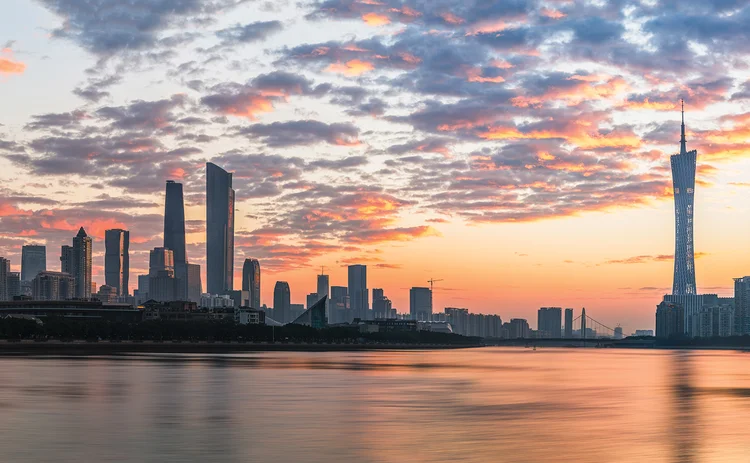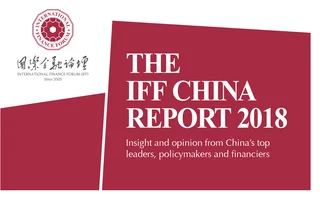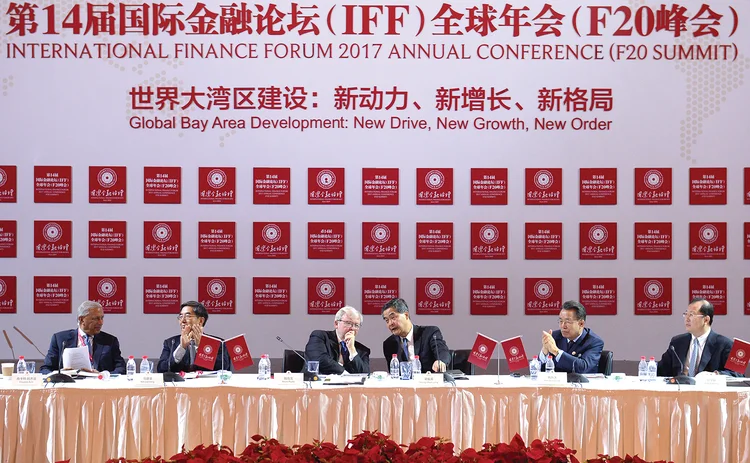
The dragon in the South China Sea
A new coastal city cluster and growth pole is rising in east Asia. Sun Shilian, researcher at Xinhua News Agency World Research Centre, and Zhang Jiaming, from the School of Economics at Nankai University, listen to experts discuss the need for national and international co-operation in its construction


The world economy currently lacks a driving force and is experiencing a continual adjustment of economic and trade investment rules as well as of economic governance systems. It is crying out for a new growth pole and power source.
Bay areas have always been major growth poles and leaders of global economic and technological development. They are also centres of global science, innovation, finance and industry. The Guangdong–Hong Kong–Macao Greater Bay Area (the Bay Area Development) will be the world’s fourth major bay area, following those in New York, San Francisco and Tokyo. The Bay Area Development in China will be in the vanguard for building world-class city clusters and participating in global competition. Experts in China and elsewhere predict that by 2030 the Bay Area Development will surpass the existing bay areas to become the world’s largest and most populous.
To achieve these goals, the International Finance Forum (IFF) put into play its established operational framework and platform, and held its 14th Annual Conference, as well as the Bay Area Development Conference, in Guangzhou. On the subject of Global Bay Area construction: New impetus, new growth and new patterns, a panel discussed the construction of the Bay Area Development and international co-operation platforms to promote stable, sustainable, balanced and inclusive growth in China and in the world economy.
Strategic significance of the Bay Area Development
In March 2015, China’s National Development and Reform Commission, Ministry of Foreign Affairs and Ministry of Commerce released Vision and actions on jointly building Silk Road Economic Belt and 21st Century Maritime Silk Road, in which developing the bay area was clearly set out for the first time. In March 2016, the Bay Area Development was addressed in Guiding opinions of the State Council on deepening Pan-Pearl River Delta regional co-operation and in China’s 13th Five-Year Plan. In March 2017, the Bay Area Development appeared in the government’s working report and in July 2017, President Xi Jinping attended the signing ceremony of the Framework agreement on deepening Guangdong–Hong Kong–Macao co-operation in the development of the Bay Area in Hong Kong.
In October 2017, the report of the 19th National Congress of the Communist Party of China (CPC) asserted that Hong Kong and Macao should be integrated into national development, focusing on the construction of the Bay Area Development, the co-operation between Guangdong, Hong Kong and Macao, as well as the regional co-operation of the Pan-Pearl River Delta. China will fully promote mutually beneficial co-operation between mainland China, Hong Kong and Macao, and will formulate well-established policies for Hong Kong and Macao residents to develop careers and operate businesses on the Chinese mainland.
The role of the Bay Area Development lies in building world-class city clusters. This is of great strategic significance for advancing and implementing the Belt and Road Initiative (BRI) and the ‘one country, two systems’ policy.
Vice-chairman of the Financial and Economic Affairs Committee of the National People’s Congress and vice-chairman of the IFF, Gu Shengzu, identifies building bay area city clusters with world-class innovation and economies as playing an important role of the Bay Area Development. He says the Bay Area Development will be an advanced city cluster and a core city with significant influence, which can lead to better division of labour and more regional co-operation. Gu also believes that the Bay Area Development would be a high-end industry group, with a well-established supporting system of modern industry and financial services, and reasonable division of labour, which is conducive to nurturing a benefit-sharing industrial value chain.
The Bay Area Development has a vibrant and innovative start-up network: within this area are several of the top 500 universities, as well as a great deal of international innovative talent. Equipped with a well-organised infrastructure network, efficient logistics system and convenient living environment, the Bay Area Development boasts high-quality resources, an open, inclusive environment and the institutional advantages of one country, two systems.
One task of the Bay Area Development is to ensure the long-term prosperity of Hong Kong and Macao, and to deepen the integration between the Chinese mainland and the two cities to ensure that the one country, two systems policy can be fully implemented.
Li Zuojun, deputy director of resources and environmental policies at the Development Centre of the State Council, says that accurately carrying out the one country, two systems policy requires the construction of the Bay Area Development, the administration of Hong Kong by Hong Kong people and of Macao by Macao people with a high degree of autonomy. Antony Leung, former financial secretary of the Hong Kong Special Administrative Region (SAR), agrees strongly with this view.
Yu Hongjun, former vice-minister of the International Liaison Department, Central Committee of the CPC, notes that the Bay Area Development is an economic engine for the BRI and a core area for the Maritime Silk Road, due to its distinct geographical advantage and role as a gateway to the vast Chinese mainland economic market. Elaborating on the relationship between the Bay Area Development and the BRI, Yu calls for the incorporation of the construction of the Bay Area Development into the BRI.

Economic and population growth
There are currently 70 million permanent residents within the Bay Area Development – around 5% of China’s total population. Xing Ziqiang, chief China economist at Morgan Stanley, believes that by 2030 the population will grow by 18 million to become the world’s most populous bay area. Research data from Shenwan Hongyuan Securities shows that in 2016 the total economic output of the Bay Area Development was around CNY9.31 trillion, equivalent to about US$1.4 trillion. Xing also believes that in the next 10 to 15 years the Bay Area Development will become the world’s largest bay area economy.
Ma Jiantang, executive vice-president of the Chinese Academy of Governance, is also confident about the future of the Bay Area Development. In his opinion, the development has three unique advantages. First, a distinct advantage in location and transportation, and a complete industrial chain with abundant technological innovation. The Bay Area Development is opening up on a larger scale, thus attracting many high-end talents, which in turn enhances global finance and services. Second, the Bay Area Development includes two SARs, two metropolitan cities and three free-trade zones – making it very competitive internally and externally. Third, it encompasses three distinctive economies and its diversity is unlike anywhere else in the world. Xing says that the planning and development of the Bay Area Development conforms to the new trends of the Chinese economy in that more consumption is driven by small and medium-sized cities in the clusters, more investments incline towards innovation and knowledge, and the rebound of investment has opened up a new direction for China’s exports.
The Bay Area Development has the potential to catch up with the other three major bay areas. Rick Niu, president and chief executive officer (CEO) of Starr Strategic Holdings and partner at Starr Finance, is mindful of the experience and challenges of New York and San Francisco’s bay areas, and asserts that typical features – such as a relatively high proportion of tertiary industry, the introduction of talented people, comprehensive law enforcement and clear differentiation – can be used for reference in the Bay Area Development. However, Niu also warns that, in the past four to five years, the New York and San Francisco bay areas have lost competitiveness to inland areas in the Midwestern and southern states of the US because of high taxation, political instability, heavy costs and regulation, and unclear incentives. On the experiences of the other three bay areas, Yao Peisheng, former Chinese ambassador to Ukraine, suggests that China should not blindly copy the model of other bay areas, and that the Bay Area Development should not be a paradise for consumers to idle away pleasurably, but a city to gather innovators. Yao says the Bay Area Development should have an innovative and advanced development concept, and plans should be made at least 30 to 50 years ahead of time.
The Bay Area Development should closely follow national strategy and interact benignly with the BRI. Beginning from the perspective of developing trade ports, Yu Liming, vice-general manager of Guoxin International Investment Corporation, proposes building the Bay Area Development as a new hub of the New Maritime Silk Road. He stresses that the Thirteen Factories – also known as the Canton Factories – were the third-largest trading posts in the world in the 19th century, and that Guangzhou has always been a prosperous, world-class metropolitan city. The rise of Hong Kong following the Opium Wars, the development of Shenzhen after the reform, and the opening up and rapid construction of the Port of Guangzhou have all endowed the Greater Bay Area with a unique culture. Alongside this regional advantage, the Bay Area Development leads the historic mission of ‘opening‑up’ China to the rest of the world. As far as international trade is concerned, the Bay Area Development has outstanding resources and capabilities, with which a China-based trading port that serves the world can be built. In addition, Yu says that Hong Kong, Shenzhen and Guangzhou as a whole have a relatively appropriate geographical span in terms of pivotal ports both at home and abroad. The three ports are located in the hinterland of southern China and are all adopting complete market operation, with Hong Kong enjoying considerable global success as a free port. Therefore, regarding Hong Kong, Shenzhen and Guangzhou ports as pivotal in the Bay Area Development is both reasonable and economical.
The Republic of Korea’s former prime minister, Han Seung-soo, believes the Bay Area Development will become China’s financial centre. He also predicts that it will play a leading role in further developing innovation. Zhu Xian, vice-president of the New Development Bank – a multilateral development bank established by the Brics states of Brazil, Russia, India, China and South Africa – says the current environment is ripe for building the Bay Area Development as its construction has global strategic significance and unlimited potential. Zhu claims that financial innovation would be the Bay Area Development’s unique advantage. The mechanism of interconnectivity makes it easier to integrate financial innovation. Therefore, a broader platform for investment and financing can be provided for enterprises to ‘Go Out’, and to march forward towards a higher global value chain.
The Bay Area Development can achieve co-ordinated development through Guangdong, Hong Kong and Macao complementing each other’s advantages. When interpreting opportunities and future directions, former Hong Kong finance secretary Leung asserts that, first, the Bay Area Development is in line with the trend of international development and, second, the world has shifted from an era led by industrial economy to a knowledge-based or innovative economy. To realise the organic combination of industrial and financial innovation, the development of the Greater Bay Area and city clusters is not only necessary, but it also conforms to the current situation and complementary advantages.
Wang Yan, deputy director of the IFF and former chief economist of the World Bank, highlights that the nine cities and two SARs appear in different parts of the ‘smiling curve’, making these regions highly complementary. China lags behind in world service trade, which hinders its manufacturing industry. However, Hong Kong and Macao have a great comparative advantage in service exports – therefore, in terms of service trade, Guangzhou should strengthen its co-operation with Hong Kong and Macao.
Institutional co-ordination of Guangdong, Hong Kong and Macao
Gu Shengzu says that the future of the Bay Area Development is promising, but its construction will be challenged by obstacles and hardships. He emphasises the problems of sectionalism, homogeneous competition and institutional obstacles in the process of bay area integration. To aid co-operation, the Bay Area Development and the Chinese mainland must narrow the divide between the operational mechanism and the institutional and cultural environment. To build a co-ordinated and innovative mechanism in the Bay Area Development, requirements must be met on the following: complementary advantage and labour division, the integration of each party’s demands, the consolidation of advantages, the shifting from individual to common development, the co-operation of research and development (R&D) with enterprises and the nurture of innovative talent. Zhu Xian also posits that the construction of the Bay Area Development faces many challenges. For example, under the principle of one country, two systems, China requires co-ordinated and innovative institutional mechanisms.
In addition to macro problems and challenges such as institutional mechanisms, some scholars have incisively identified specific problems that might be encountered during construction. Xia Le, Asia chief economist at BBVA, believes that the Bay Area Development means to achieve balance, and that long-standing competition in the three regions should be repaired and adjusted. However, he also says that the government must consider how to maintain an open and competitive market while carrying out intervention.
One of the most crucial experiences of the past 30 years is that competition between local governments can lead to economic success, but the boundary between government and the market should be carefully drawn. Xia also notes that the Bay Area Development must streamline the flow of information. Research and education should be improved on the Chinese mainland, and it is important to ingest information from the outside world.
Unfortunately, both information and the flow of talent are hindered, while attracting talent and alleviating poverty also brings challenges. If a city wants to retain its talent, housing problems need to be resolved – governments need to contemplate how housing costs can be reduced and renting markets can be developed. At the same time, policies on adjusting building indicators inside the Bay Area Development, as well as market-based housing subsidies outside of it, deserve attention. Currently, around one million people living in Hong Kong are below the poverty line. If income distribution cannot be improved – however rapid the pace of the development – it cannot be regarded as a success. These insights are applauded by participating experts and scholars. The division of the Bay Area Development – such as with barriers between markets, capital and talent – impedes interconnection and interworking. Antony Leung believes that, if China wants to develop the Greater Bay Area to be the largest, most economically successful bay area in the world, it must break down these barriers, even if it takes time.
Leading on innovation
Following Guangdong, relying on Hong Kong and Macao
In developing the Greater Bay Area, China should be aware of regional differences, which participating experts recognise. On this basis, Guangdong, Hong Kong and Macao will be able to exert their own respective advantages and promote mutual development.
Chen Bingcai, inspector at the Ministry of National Administration, posits that Guangdong should play the leading role in the construction of the Bay Area Development, with Hong Kong and Macao providing assistance. In the past 15 years, the total economic output in Guangdong has increased by a factor of eight to nine. If Guangdong takes the lead and other regions develop accordingly, advantages can be fully applied. The division of labour and co-operation among cities is a great advantage to economic development. The city clusters, regardless of size, should have specialised divisions of labour, rather than concentrating resources in central cities.
Experts from Hong Kong believe the SAR could support the development of the Greater Bay Area by providing talent and financial leverage. Antony Leung suggests two essential contributions that Hong Kong might make. First, talent attraction – Hong Kong, international and diverse, with easy access to education and medicine, is institutionally favoured by much overseas talent and can serve as a long-term centre for gathering international talent. Second, finance, as Hong Kong is a global financial centre. According to Leung, Hong Kong should work with neighbouring regions – especially Shenzhen and Guangzhou – to develop high-end industries such as biotechnology, big data and artificial intelligence. He highlights three points in respect to more prosperous development: a breakthrough of different economic elements flowing between Hong Kong and mainland China; increasing collaboration in industries such as biotechnology and big data; and a higher level of co-ordination mechanism should be established in the context of one country, two systems.
Hu Weixing, professor of politics and public administration at Hong Kong University, concludes that Hong Kong can play the role of ‘super co-ordinator’ in developing the Greater Bay Area. He lists what he believes are Hong Kong’s three major advantages: the financial services industry, the competitiveness of its professional services and its natural ties for international exchange and co-operation. Besides being the super co-ordinator, Hong Kong should also actively participate in construction to further integrate into the Bay Area Development and achieve wide consultation, joint contribution and shared benefits.
In this regard, Hu makes two suggestions. First, business departments in the two SARs, nine cities and Guangdong Province should communicate honestly and clearly to fully implement policies and projects. Second, people-to-people exchange is a key factor in the Bay Area Development. To this end, he proposes mutually beneficial co-operation between mainland China, Hong Kong and Macao, and to improve policies for Hong Kong and Macao residents to develop in the Chinese mainland, emphasising the historical responsibility of their compatriots for national awareness and patriotism, and to share in the national rejuvenation as well as prosperity and glory.
Strengthening top-level design
Yu Hongjun, formerly of the Central Committee of the CPC, believes China must achieve co-ordinated development under a well-organised top-level design. He suggests that in terms of policies, first of all, a unified plan and outline needs to be formulated; second, cultural exchanges, dialogues and co-operation should be strengthened between enterprises, public institutions, scientific research and teaching institutions, and mass media; third, interconnected infrastructures should be established in Guangdong, Hong Kong and Macao. Deep exploration of institutional mechanisms and standards should be made to cater to all three locations. Zhu Xian argues that two of the most important internal factors for the Bay Area Development are the integration and division of labour. The Bay Area Development is intended to promote economic integration between Hong Kong, Macao and the Pearl River Delta, which requires important top-level design to promote the rational division of labour and avoid internal friction and redundancy.
The Bay Area Development can also serve as an experimental field for innovative co-operation exploring new modes of regional development. Chen Xuanqing, former inspector of the National Development and Reform Commission, suggests the Bay Area Development should speed up innovation in four main areas.
First, innovation should be considered in terms of a co-operation platform. Following the principles of co-ordinated development, resource sharing and mutual complementarity, industries of different types, levels and sizes should be integrated. Major co-operation platforms for advanced and competitive industries, modern services industries and strategic emerging industries should also be established, and key laboratories and engineering centres should be promoted. Second, China needs to bring forward new ideas for co-operation mechanisms. Infrastructure in different areas should be brought into line, and the mechanism for cross-border infrastructure construction must be improved. Cross-border port management should be strengthened. Further strategic co-operation in intellectual property should be carried out. In addition, new mechanisms concerning areas such as regional financial security, governance incentives, population monitoring and low-carbon development and co-operation should be established. Guangdong, Hong Kong and Macao should jointly establish a demonstration project for low-carbon development within the Bay Area Development to accelerate the formation of a green economy. Third, China should introduce innovative joint projects and strengthen its infrastructure interconnections. Guangdong, Hong Kong and Macao should jointly release the project of three networks and one centre, which is the network of multi-way channel, air and sea routes and rapid bus transit, as well as the centre of world-class shipping logistics. The Hong Kong International Shipping Centre will be the heart, and Shenzhen and Guangzhou will be container port hubs. Major science and technology programmes should be supported to build a financial circle. Fourth, China should create new policies of co-operation to promote liquidity in a unified market. High-level co-ordination and dialogue mechanisms should be improved to increase connectivity. Under the leadership of central government, China needs to work in unison to become a world-class bay area and city cluster.
Participating experts say the Bay Area Development must always fit the concept of a co-ordinated development, with the ultimate goal of integrated construction. Li Zuojun asserts the importance of integrated construction in the following aspects: ideology and understanding; institutional mechanisms; rules and policies; industrial development; infrastructure construction; urban systems; market development; environmental standards; public services; and brand services.
Building a modernised economic system
The Bay Area Development must always adhere to the innovation-driven strategy and promote regional development through technological improvement. Former prime minister of Japan Yukio Hatoyama says that universities play a crucial role in innovation and start-up businesses. He notes the many universities in the Bay Area Development – Guangzhou currently has more than one million registered students, who will have a great impact on the future economy. Zhang Yansheng, chief researcher at the China Centre for International Economic Exchanges, undertook a comparative study of scientific and technological innovation in Guangdong and Hong Kong. He found that, using an index to measure the density of R&D investment, Guangdong has reached 2.56%, which exceeds the average level of developed countries and means that Guangdong has already entered the preliminary level of an innovation-driven society. In the Bay Area Development, meanwhile, the density of R&D investment is relatively low, at 0.73%. However, Hong Kong has four top-ranking universities and world-class systems for direct investment and financing, in addition to a well-organised market economy and law enforcement. Chen Bingcai proposes to develop the Greater Bay Area as a hub and model zone of transformation, upgrade and innovation. This goal can only be achieved by focusing on environmental and ecological technology, social governance, innovation in technology and products, protection of intellectual property rights, and basic education and research investment.
Finance is one of the core competitive advantages of the Bay Area Development and plays a leading role in the construction of modern economic systems. Li Dongrong, president of the National Internet Finance Association of China and former deputy governor of the People’s Bank of China, puts forward some suggestions concerning the financial services system in the Bay Area Development. First, Li believes China should build a competitive global bay area with an effective and suitable financial services system. Financial markets need to be given full access to facilitate resource allocation. Thus, China can provide highly efficient financial services support to scientific and technological innovation, industrial upgrading and economic development. Second, China must give scope to financial services systems in the construction process. By measuring various economic situations, comparative advantages, industrial distribution and resources endowment, China can strengthen financial co-operation in different areas and provide financial services in an appropriate manner to achieve benign interaction and co-ordinated development. Third, fintech should be an active part of today’s financial services systems. Internet finance is an emerging area of competition and resource distribution in various countries and regions in the digital age, and the Bay Area Development has important geographical advantages in the development of fintech.
The Bay Area Development needs to gather not only wealth but talent. Zhuang Enyue, vice-president of China Cinda Asset Management, suggests the introduction of more modern financial talent – especially those capable of activating assets and turning waste into value, and those with philosophical and technological mind-sets. Omar Shahzad, CEO of Meinhardt in Singapore, proposes that a well-structured Bay Area Development could effectively reduce labour costs and improve competitiveness. To encourage the introduction of talent, the Bay Area Development should be more open to welcoming and attracting global talent.
The Bay Area Development can no longer follow the old path that leads to high contamination, high energy consumption and high emissions. Han Seung-soo, former prime minister of the Republic of Korea, says the Bay Area Development, China and the whole world must shift from brown growth to green growth. He highlights the Republic of Korea’s global green-growth agency, which was set up in 2010 and has already become an international institution. The IFF could also set up a green-growth centre that undertakes green finance, climate change and renewable energy research. Relying on the resources of the IFF, the green-growth centre could evolve into a heavyweight research institute in China and perhaps the rest of the world.
Ye Yanfei, inspector of the China Banking Regulatory Commission Policy Research Bureau and an expert on green finance, believes the Bay Area Development should be characterised by green finance. He suggests first trying the free flow of green capital, or setting up a green capital market to attract overseas businesses as well as BRI enterprises. Governments could issue green bonds in this area and attract overseas capital to invest in green industries. He is also confident that the green capital market will become the most popular capital market in the world.
Zhang Jianyu, Chinese programme director of the Environmental Defence Fund, proposes that the development of a green supply chain would be an important component of the Bay Area Development. To develop a green supply chain means that environmental requirements need to be added into business chain management, including efficiency, energy saving, water saving, power saving and low-carbon environmental protection. Zhang Jianyu says that China is the first to advocate a green supply‑chain network in the Asia-Pacific region to promote green and integrated development. Currently, the green supply chain in Dongguan, within the Bay Area Development, has performed outstandingly. Under the leadership of municipal government, the Dongguan Index serves not only as a benchmark for manufacturing industries, but as a specific measure for energy conservation and efficiency improvement. As a global green supply-chain centre, the Bay Area Development should be a birthplace of global green organisation and a hotbed of green innovation.
Building a community of common destiny
The Ministry of National Administration’s Chen Bingcai identifies that the BRI has no strings or market access attached and all related trade agreements are on an equal basis. China will also provide sufficient technology, capital and equipment support, all of which have comparative competitive advantages.
Hu Biliang, dean of the Belt and Road Research Institute of Beijing Normal University, has carried out an in-depth study of the BRI. He explored the topic of promoting stable development of the BRI in the Bay Area Development, and believes the core aim of the BRI is to strengthen the relationship between policy connectivity, economic co-operation and trade, infrastructure connectivity, financial support and people-to-people exchanges. As well as the aforementioned aspects, China must also make effective use of the Bay Area Development as a good vector for development. Other port cities around the world have successful experience worth learning from.
The readiness to begin development of the Greater Bay Area stretches across China, and Guangdong, Hong Kong and Macao have obvious location and resource advantages. China’s proposal of the BRI is a firm step towards further opening‑up and, alongside this initiative, the Bay Area Development’s future looks very promising. Hu Biliang considers a further three crucially important factors in the BRI and the Bay Area Development’s interdependence. First, opening‑up should be synchronised. China should take into consideration all aspects, including the financial system, exchange rate management, services and agriculture. Second, the co-ordination of internal and external factors should work in harmony. Third, China should attract top-quality talent from home and abroad, which requires further optimisation of talent policies.
Only users who have a paid subscription or are part of a corporate subscription are able to print or copy content.
To access these options, along with all other subscription benefits, please contact info@centralbanking.com or view our subscription options here: subscriptions.centralbanking.com/subscribe
You are currently unable to print this content. Please contact info@centralbanking.com to find out more.
You are currently unable to copy this content. Please contact info@centralbanking.com to find out more.
Copyright Infopro Digital Limited. All rights reserved.
As outlined in our terms and conditions, https://www.infopro-digital.com/terms-and-conditions/subscriptions/ (point 2.4), printing is limited to a single copy.
If you would like to purchase additional rights please email info@centralbanking.com test test test
Copyright Infopro Digital Limited. All rights reserved.
You may share this content using our article tools. As outlined in our terms and conditions, https://www.infopro-digital.com/terms-and-conditions/subscriptions/ (clause 2.4), an Authorised User may only make one copy of the materials for their own personal use. You must also comply with the restrictions in clause 2.5.
If you would like to purchase additional rights please email info@centralbanking.com test test test







